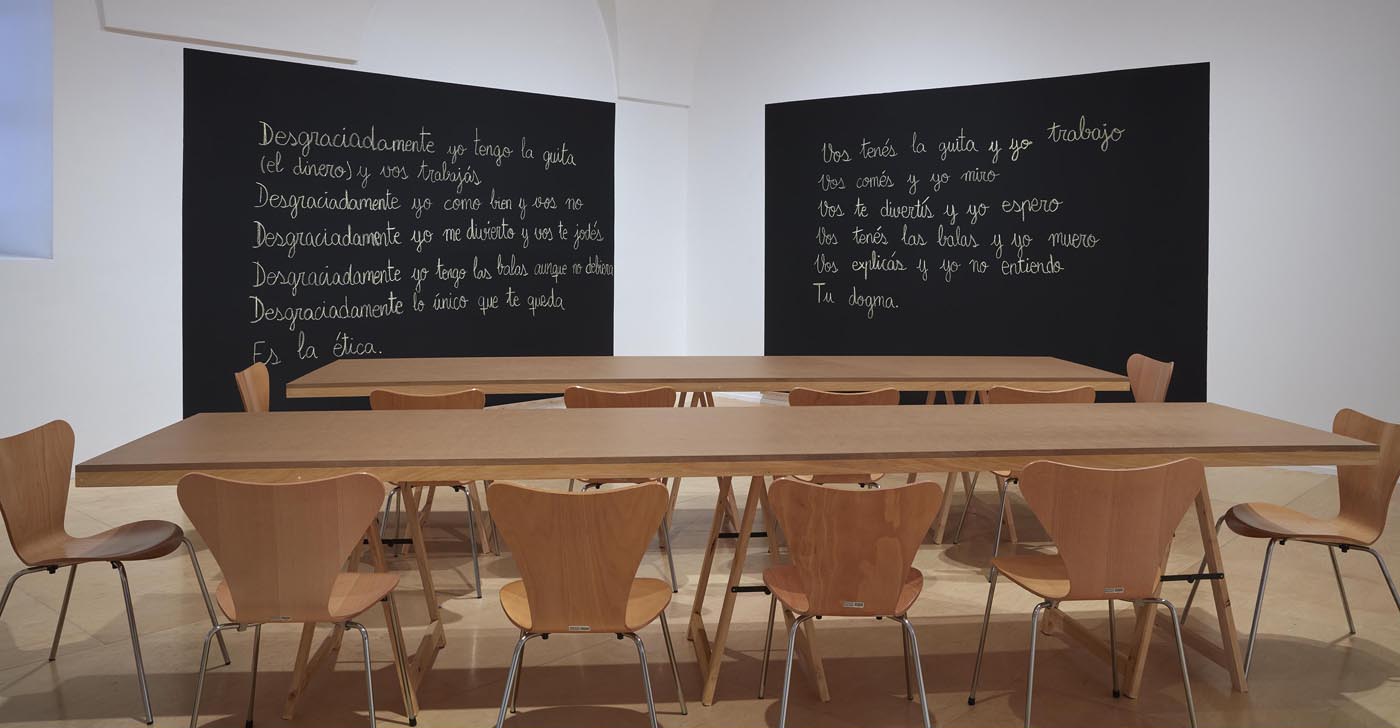Aesthetics of Dispersion
09/05/2022
To think of Antonio Caro (Bogotá, Colombia, 1950–2021) as a teacher-artist because he gave workshops that he considered part of his oeuvre, makes us neglect or lose sight of the educational potential of the rest of his plastic work. (...) His insistence on distrusting novelty and thinking more of iteration as a model of production, his way of staying away from the usual demands, fetishization, and positivism of the visual/plastic arts, makes his work a remover of bourgeois values.
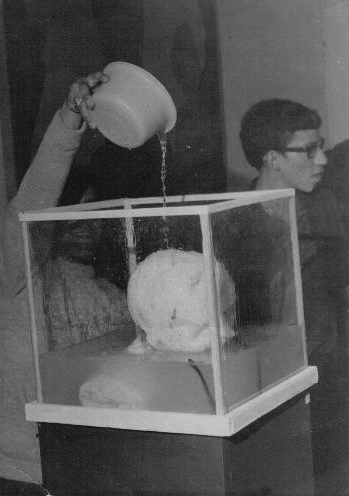
«The definition of artistic activity occurs, first of all, in the field of distribution».
«An object disappears when it becomes a weapon».
Having an interest in education is not what makes an artist an educator. All works of art are expected to be educational, not because they teach a particular content or because they represent this or that idea but because an artwork embodies in itself the experience of facing opacity. We are placed before something we cannot fully codify, and that experience of untranslatability is potentially educational; it is an invitation to expand the limits of what is possible. Hopefully, a work of art is like a loving relationship: an opportunity—a laboratory—for otherness, not so much for the encounter but for how we face misunderstandings. The other is another as long as they take us by surprise and the encounter crushes our certainties. In this sense, every aesthetic experience is an event, and as such, an educational instance.
To think of Antonio Caro (Bogotá, Colombia, 1950–2021) as a teacher-artist because he gave workshops that he considered part of his oeuvre, makes us neglect or lose sight of the educational potential of the rest of his plastic work. It is known that education and emancipation are two concepts that go hand in hand. Caro's insistence on distrusting novelty and thinking more of iteration as a model of production, his way of staying away from the usual demands, fetishization, and positivism of the visual/plastic arts, makes his work a remover of bourgeois values.
From the Emphasis on the Object to the Emphasis on Circulation
For Seth Price, today a music album could be regarded as a more successful instance of public art than a monument tucked away in an urban plaza. The former is more linked to the idea of "turning art into a public good," while "the monumental model is more linked to the idea of making art a public good."1 Meanwhile, "the monumental model of public art is invested in an anachronistic notion of communal appreciation transposed from the church to the museum to the outdoors."2 The music album emphasizes the distribution of an idea or an affection, while the logic of the monument leans towards fetishizing an object, and to a certain extent, implies a defense of the status quo—that is: the idea of establishing a narrative. Price goes further by affirming that the mere act of situating any work of art at a singular point in space and time turns it into a monument.3 In that sense, the museographic practice is, to some extent, linked to the idea of protecting the value of private property and merchandise. “What if it is instead dispersed and reproduced, its value approaching zero as its accessibility rises?”4 It seems that Caro's work started from such a paradoxical challenge.
The climate of the time when Caro's works first appeared was shaped, partly, by conceptual art made to be understood by only a few,5 and partly by anti-bourgeois art that replicated the strategies of circulation and representation of bourgeois art.6 In Colombia, and perhaps in Latin America, the terms and categories to name the new artistic manifestations did not yet exist. By that time, there were still remnants of the classic discussion regarding abstraction (bourgeois) vs. figuration (involved). In this discursive context, Caro's work introduced the question of the spectator, which, according to Luis Camnitzer, is the contribution that conceptual art introduces in Latin America: "How do you get the audience to participate in the work of art? How much ambiguity can remain in the work without deviating from its political mission? How could you have in the same work a search for mystery and education for the non-initiated at the same time, without being hermetic or obvious?"7
For those who don’t know him, allow me the introduction: Antonio Caro used the logos of Marlboro (1973) and Cocacola (1976) to write the word 'Colombia' with those typographies; he printed the signature of the Colombian indigenous leader Manuel Quintín Lame in slips of papers and distributed it together with information about his life and work (1972); he wrote the phrase AQUÍNOCABEELARTE [ARTDOESNOTFITHERE] (1972) on cardboard and under each letter was the name of every person killed in the massacres perpetrated by the government after numerous demonstrations occurred in 1971; he installed cardboard tigers at the entrance of a museum and laid out a red piece of silk on which he wrote: El imperialismo es un tigre de papel [Imperialism Is a Paper Tiger] (1973). And all this at a time when students were denouncing the U.S. intervention in public universities, when the left-right political discussion was buoying, binary, omnipresent, and, in Caro's own words, dogmatic.
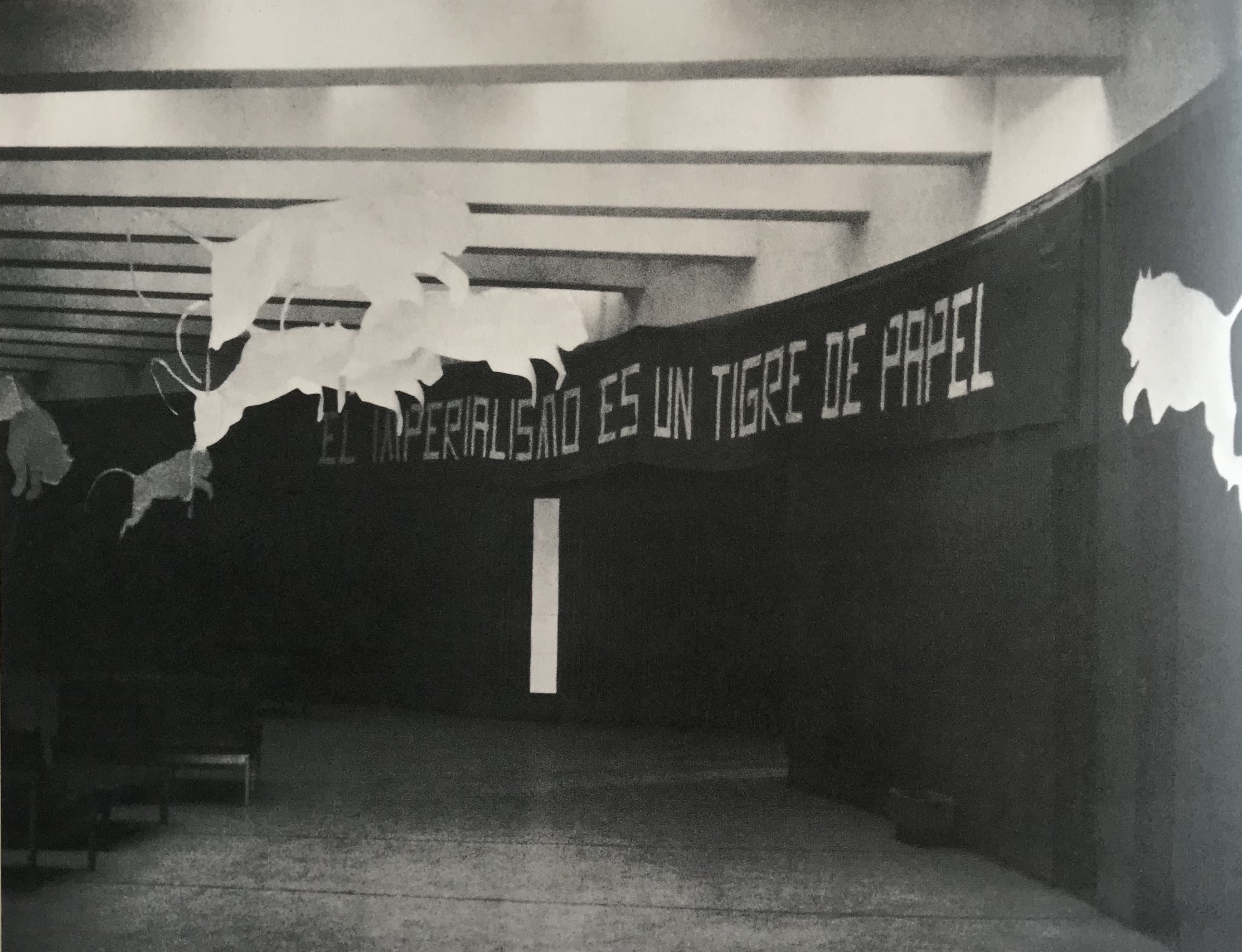




In 1992, in the context of the commemoration of the five hundredth anniversary of the discovery of the Americas, he made three ceramic seals like the ones used by different pre-Columbian tribes for the Ante América exhibition. One seal had the number five and the other two had a zero. With them and using achiote seeds, he printed the number 500 and gave multiple lectures in which he spoke humorously and critically about this foundational episode and its repercussions to this day. The slips of paper with the number 500 were mainly a way to spread the word about the lectures, according to Caro himself8 —Hágalo usted mismo [Do It Yourself] (1992). He also drew a corn plant (the native American indigenous food par excellence) that became a mail stamp and a mural repeated countless times (1983).
In addition to the aforementioned (which are among his best-known gestures), there are two other works that are even more radical in their dematerialization. His debut on the Colombian art scene was with a bust of the then president made from salt. Installed in a glass vitrine, he poured water over it and the figure progressively dissolved. Unintentionally—the vitrine was badly constructed—the water began to leak into the exhibition space, and this major mistake catapulted him, making him visible in the local art scene at the age of 20 (1970). Shortly after, in 1973, he submitted his work Colombia Marlboro to the most important national art salon and was rejected. A gallery owner9 approached him and offered to show it in her space, which was close to the museum where the salon was to take place. The exhibition was, in Caro's words, "an ambience space, what is known today as an installation." In addition to slides with scenes from Bogota, there was young people’s music: salsa and rock. It opened on the same day as the art salon, so Caro crossed the street and asked the press to follow him and document what he was about to do. He approached the event organizers and publicly slapped the cheek of one of the jurors who had rejected his project.
He gave this act the status of artwork a year later and called it Defienda su talento [Defend your talent] (1974). He configured it as a wall drawing and a series of posters that had only the figure of a hand (the one he used to give the slap) and the title of the work. Returning to the exhibition, the opening consisted of an invitation for the visitors to help him dismantle the exhibition: erase the drawings and paint back the walls so that the gallery would be ready for the next show. People would ask him: Why are you doing an exhibition where nothing is for sale? "Because this is an exhibition for showing, not for buying!"10 —the artist and the gallerist replied. Perhaps this may seem usual now but in such a conservative country and in such a bourgeois sphere as the Colombian art scene of that time, it was a way of proceeding that became foundational.
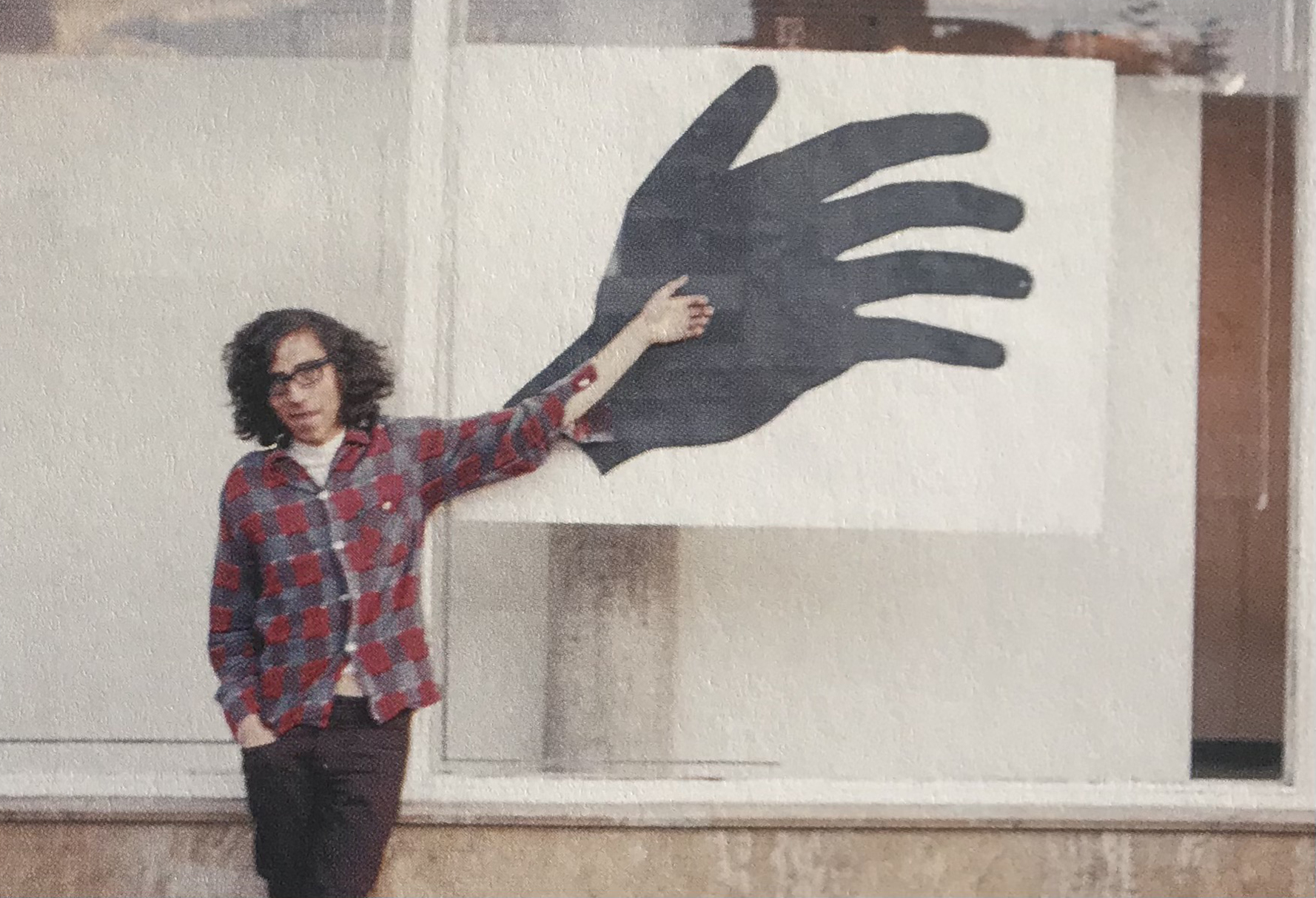
Dispersion
His plastic work seemed to arise from a motivation analogous to that of the visual creativity workshops he taught (and to which he attached great importance): to make art available for everyone. Since it is for everyone, it has no owner either, as his works such as the drawings on walls (without the grandiloquence of muralism) seemed to suggest. Caro gave away little slips of paper with recipes, he introduced phrases and words moving them around through posters and lectures. In his work, everything gets dispersed (cards, posters, words). His slips of paper are like the music album Price talks about: they oppose the idea of a monument. His work was not static and the focus was not on the object but on its distribution. Even the salt bust, his first work, rejected the solidification of form and relied on the aesthetics of what is dispersed in its immateriality. Similarly, his work Defienda su talento consisted of an expanding rumor, rather than an engraving placed in a gallery. He seemed to state that the work is not an object but an act (that of circulating, distributing, dispersing, dissolving), that the work is not only the visible part, the solid thing susceptible to being fetishized and turned into private property.
Insertion
Caro inserted himself into pre-existing channels (advertising, for example) to contaminate the message: hijacking a symbol to return it to us profaned.11 A "semiotic guerrilla," as Camnitzer12 has pointed out, or as some sort of Robin Hood: he stole and recirculated. If Cildo Meireles inserted himself into ideological circuits through the use of Cocacola bottles, Antonio Caro made an "artistic intervention into national texts."13 For Seth Price, there are works that simply "reference" the codes of mass culture, whereas other works embrace these codes as forms.14 These "insertion" type of gestures do not use the market or consumption as a theme15 but infiltrate them and create a ripple there: they effect a contamination, a distortion. And this is what Antonio Caro did, instead of representing an "anti-consumption" theme, he inserted himself into the visual distribution of those symbols related to consumption and altered it. He used information and discursive contexts as matter. This displacement is not minor, it is a displacement from a representational (illustrative)16 paradigm to a performative paradigm.

Although he never spoke in those terms, we can infer this from his work in an attempt to gauge its scope. By "performative paradigm" I mean a way of seeing/producing the work of art not as a representation of reality but as a device that is configured as such (that begins to exist as a work) at the very moment of its circulation: the effects it produces become part of the work. Whereas the illustrative perspective argues that the represented object pre-exists representation, that both instances are static, that they do not transform each other, and that the function of art is mimetic. The model of insertion into ideological circuits initiated by Cildo Meireles in Latin America removes this conservative vision of the work of art; Antonio Caro participated in the construction of this paradigm. This model shows us that the work is not an object but an effect: it is not the intrinsic/essential qualities of an object—its craft, the genius and originality of the person who produced it. Instead, the emphasis is placed on the effects the object produces, on how it transforms its circulation channels while being transformed by them. This gesture is an epistemological contribution, as it affects our cognitive apparatus by questioning the basic mechanism of representation: the linear, mechanistic, and binary model that holds the notion of the work of art as the representation of a theme becomes more elaborate, proposing a more complex vision of the relationship between the work and the world. In this sense, the work of art is no longer thought from an essentialist vision, and in doing so, it consequently deactivates the notion based on the taste of the work of art as a commodity.
This is an example of how education and emancipation go hand in hand. The pedagogical contribution of Caro’s work (which allows us to shake the bases on which our cognition is structured and, therefore, our link with art) is a political contribution at the same time, which in turn democratizes art. Antonio Caro chose not to identify himself as a political artist once he perceived that the orthodox left was rejecting his work; he then said that he had freed himself from the pressure of creating his works from a "leftist method" or from "biases."17 Unintendedly, perhaps he gave the self-proclaimed political art a vision that it really needed at that moment: that it’s not so much a matter of the content of the images we produce but of the mechanism we use produce them, and how we send them off into circulation. To think that epistemological crises are also political reminisces Camnitzer’s assertion that “there is no need for a separate program to produce pedagogy in art when the very ideology behind the art is already pedagogical.”18
Iteration
As Gina McDaniel points out, iteration is a fundamental modus operandi in the artist's oeuvre. Caro's works were not many or very different from one another. It could be said that the strategy was very similar in all of them, so in every exhibition he participated in, the viewer almost always saw—apparently—the same thing. By repeating a work so insistently, he seemed to insist on the idea that the object itself is not the relevant part but where and how it circulates; as if the what of the object did not matter (essentialism) but how it works, how it operates (pragmatism). But even more important is the fact that the strategy of iteration rejects the idea of novelty and originality on which the notion of art as a commodity is based.
By pushing these issues into crisis, the work of art distances itself from the "illustrative and hedonistic" (taste-based) paradigm that we are used to and turns the work of art into an opportunity for the viewer to experience opacity: an opportunity to confront otherness, something difficult, something one does not know how to classify. Caro's work is educational because it produced a difference at the time it emerged, presenting the local art field with the problem of solving what to do with it: how to name it, whether to welcome or expel it; some allowed themselves to be questioned by it, others exoticized the character, and others ignored its contribution.
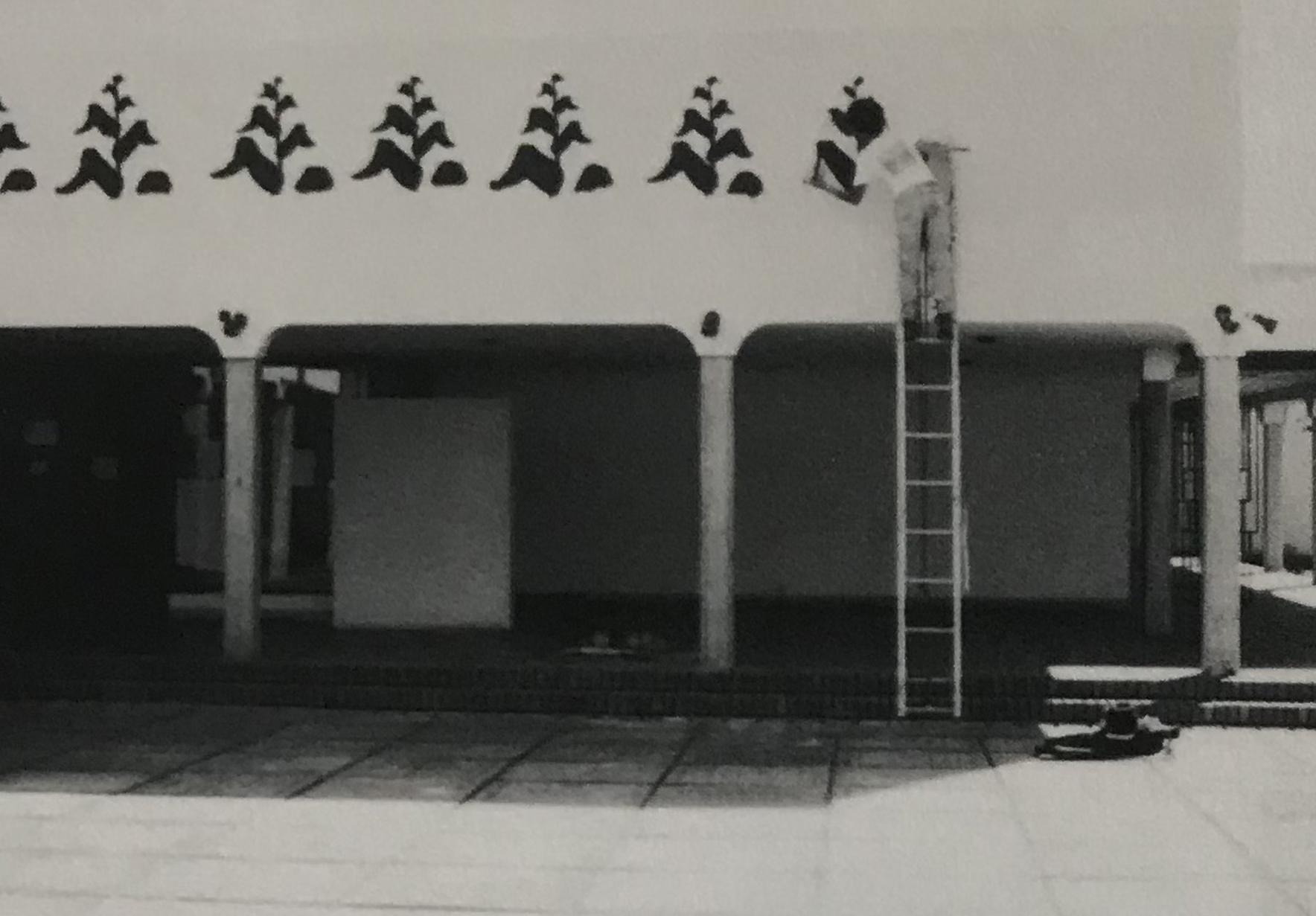
All the ripples produced by his work would not have been possible without the places of enunciation that Caro built for himself: anti-dogmatic, anti-academic, unabashed. That’s why it is not odd to find two hand-picked quotes in the book he published with anecdotes from his visual creativity workshops—one from Mick Jagger and another from the Tao, both somehow related to detachment:
«The moment you start to believe you’re important, you become less creative.»19
«To create without possessing, to help expecting nothing in return, to guide without intending to dominate, this is the greatest virtue.»20
Decentering the work of art from the object was an endeavor carried out by conceptual art, and according to Camnitzer, Latin American conceptualism introduced the question for the audience, and therefore, the emphasis on the work of art as problem-solving—that is to say, as a pedagogical instance. Caro's work is part of this shared project (perhaps unintentionally and without being really aware of his belonging to this endeavor), and he introduced some issues of his own too, such as the emphasis on the local. He took on as a theme what was seen as otherness (especially at the time when his works appeared): the presence of indigenous and peasant life in Colombian culture. His gestures are pedagogical because they keep producing, over and over again, the illegal connections that Camnitzer speaks of.
His quest was above all non-programmatic. Antonio Caro would say things like: "the wild character of my production"21 or that he operated with an “a posteriori by a fluke theory,”22 that he did not plan his works as they were rather “encounters.” Letting things happen without planning them beforehand is one of the most distinctive traits of artistic production in contrast with production in other fields: accepting not knowing, the lack of a program or previous knowledge. However, it is often demanded of art—especially in academic instances or open calls—that artists know in advance what they are going to do and the scope of resonance of what they are going to do; thus creating a sort of corporate modus operandi, as if we were producing goods and services. Caro reminds us of the performative dimension of art-making: the work is not a representation of previous knowledge, knowledge is enacted as the work is being made.
There is a certain criticality, that is, a pedagogical intention in acknowledging and emphasizing uncertainty as a fundamental part of the production process in art, because we must not forget that a commodity is everything we know what to expect of it, how it works and what it is for.23 So much of the critical thinking that Antonio Caro contributed lies in not realizing the full depth of his contribution.

